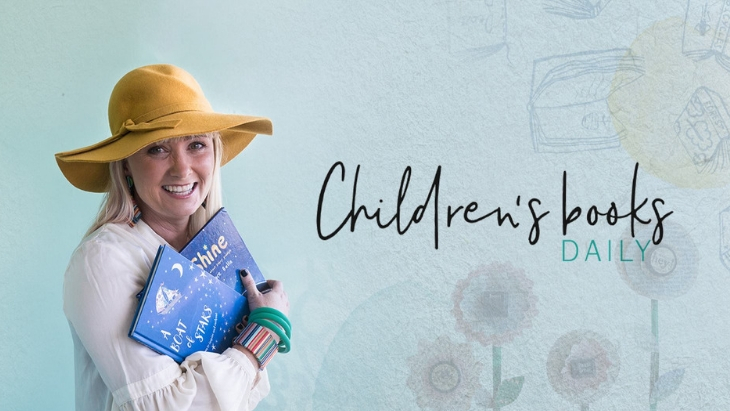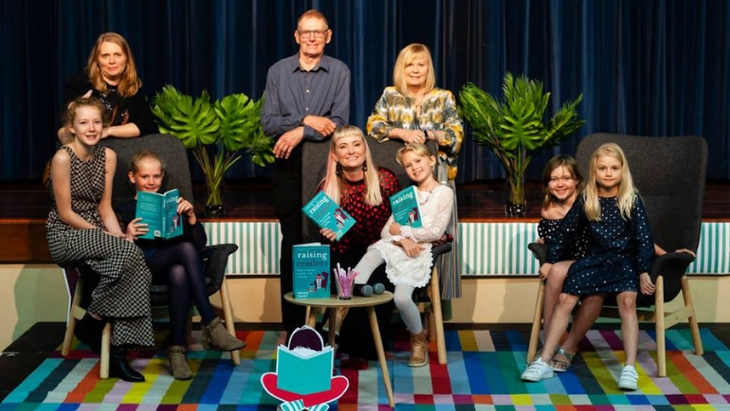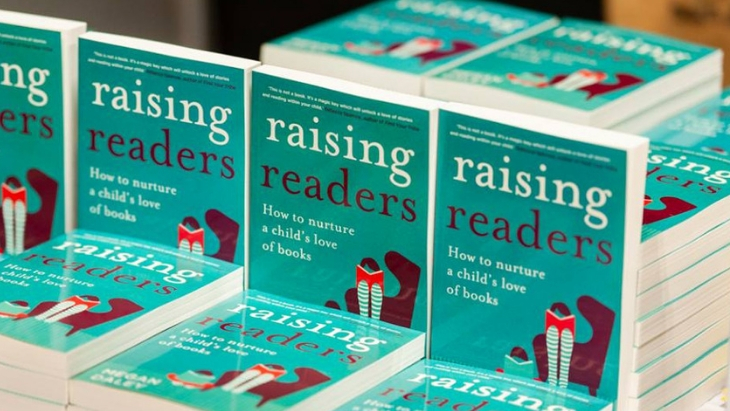Q&A With Raising Readers Author Megan Daley
- Mums & Bubs
Toddlers
Preschoolers
Kids
All Ages

Megan Daley lives and breathes books – and she has her whole life. Memories of her childhood are filled with bedtime stories with her dad and life-changing books brought home by her teacher librarian mother. These days she is a mother herself to two equally book-mad daughters, an exuberant (and award-winning) teacher librarian, passionate book blogger, and now author.
In her book, Raising Readers – How To Nurture A Child’s Love Of Books, Megan imparts more than 20 years of literary experience and knowledge to help you grow a love of reading in your child.
Raising Readers isn’t your average resource book or how-to guide for parents and teachers. From endpaper to beautiful endpaper, it is filled with Megan’s effervescent conversational style and contagious passion for books. So, grab a cuppa and a slice of cake and settle in for a chat with Raising Readers author, Megan Daley. She wouldn’t want it any other way.

What is your earliest memory of reading?
My earliest memory of reading is of being read to by my dad. Dad was a great bedtime books reader and though I don't remember all the books he read me, I do remember feeling close to him and I do remember that he did great funny voices! My earliest memory of independent reading is from much, much later down the track! I was a tween around the time my mum started a postgraduate qualification in teacher librarianship (at the time she was a high school art teacher) and I distinctly remember some amazing books coming into our lives around this time. Books like So Much to Tell You by John Marsden and the Homecoming series by Cynthia Voigt absolutely connected with me and I was probably at exactly the right age to explore some of the books that had ‘big themes’ in them. Thirty years later those books remain among my favourites.
What was your favourite book as a child?
Definitely the two mentioned above, which I would have read around age 11 or 12. As a young child my favourite book was Little Cloud and Mean Mountain by Robert Talon. To be honest, when I read Little Cloud and Mean Mountain I kind of wince – it’s preachy and not particularly sophisticated in text or visuals but favourite childhood books are not always about the content. For me that book was my favourite as it was an end of year gift from the Oxley Police Academy Santa (where my dad worked at the time – those Christmas parties were great!) and my dad read it to me over and over. It was a favourite because of emotional reasons rather than because it was good! I did also love Winnie the Pooh. My first independent overseas trip was in my early twenties and I went to the town where Winnie the Pooh was written by A.A. Milne, specifically to play Poohsticks.
In Raising Readers, you talk about incidental reading. What is this and why is it important?
Incidental reading is like incidental exercise, and fitness experts bang on about that so I figure a teacher librarian can bang on about incidental reading! Incidental reading is the reading that occurs in the pockets of time we find in our busy lives – waiting for an older sibling to finish football training, at the doctor’s surgery, waiting for mum to inhale her lifesaving coffee at the local café. Yes, it’s easy to pull out a device, and I do partake in this parenting strategy as I am human. But it is also a great habit to always have a book or kids’ magazine on hand. I have books stowed in the car, my handbag, under my desk at work and on the kitchen table. My children will always pick up a picture book and read it at the kitchen table when they are avoiding the reality of putting their plate in the dishwasher and they often grab a book from the seat pocket of the car. Once they ‘fall into’ a book after a page or two they will almost always keep reading. Having a book on hand is a great habit to form.
I sometimes wonder if my child is reading her home reader or if she has memorised it. Does it matter if early readers memorise words? How can we help children improve their reading comprehension daily?
Absolutely, she’s probably memorised many of the words in her home reader! And it doesn’t matter a jot! Home readers are a teaching tool, an instructional device used to teach the mechanics of reading. When used correctly by great early childhood teachers, home readers are an effective means to teach the skills needed to read. Memorising the words helps your daughter to read with more confidence and work on her fluency, as does reading readers which some parents might consider ‘too easy’. Good teachers know when to work on developing confidence and reading fluency and will often slot in some readers at a lower level to give a boost to reading self-esteem. They know when to push your little reader with a harder home reader and they know when to move them to the next level. Teachers are the brains behind home readers. One of my favourite sections in my book Raising Readers is the section written by Pamela Rushby on how home readers are written and why they exist – fascinating and insightful!
Reading comprehension is another matter altogether. It’s important to check your child comprehends the subject matter of their home reader with a few simple questions about the setting, asking them to re-tell the plot and maybe talking about who their favourite character is and why. Even better than this however, is ‘talking books’ with your child as you read to them – at bedtime or as part of homework. Books which are self-selected from your child’s school library are the best way to increase comprehension. Predict what the book might be about based on the cover and endpapers, chat about the characters and talk about why your child did or didn’t like the book. Ask both simple recall questions (what was the game Winnie the Pooh played on the bridge?) and complex ones which develop critical thinking (why do you think Eeyore is so grumbly all the time? How might Winnie the Pooh cheer him up? How do you cheer your friends up?).
What are your top three tips for getting reluctant readers interested in reading?
Every reader is different, but I really think the best ways to encourage a reluctant reader are:
- Model reading to them – the adults in their life have to model enjoying reading and making time for reading.
- Bring a book to life by taking them to meet an author at a book launch or literature festival. Often the most reluctant of readers will be inspired by rock star authors like Jacqueline Harvey or Tristan Bancks.
- Bribe. Surprised to hear a teacher librarian condone this? Look it’s just a reality. If you have to offer incentives to read then go for it, developing a reading habit is too important to not pull out all the big guns of parenting. If a book is good enough, they will eventually read it for joy rather than reward.
What advice do you have for kids who say they are ‘no good at reading’?
Every single child deserves an identity as a reader and parents, caregivers and teachers must work together to ensure that children don’t feel and verbalise, ‘I’m no good at reading’. Adults also need to be super careful to not say that a child ‘is just not a reader’ or ‘is just no good at reading’ – we can sometimes inadvertently send the message that we’ve given up on them in terms of reading and are just going to let them focus their energies on things they are good at – whether that be Maths or sports. Some children may never list reading in their top five talents or list of favourite pastimes, but every child should see themselves as a reader on some level. For some children they may ‘read’ using audio book only, or they may consume graphic novels or fishing magazines – but it is all reading.
For those kids who are voracious readers, what is the best way to extend their reading ability?
Keen readers will consume books at a great rate and sometimes parents and caregivers think this means they should keep reading books which are more and more complex and just ‘bigger’. In fact, I think keen readers should be encouraged to go sideways with their reading and read across different genres, rather than just reading thicker books. Have a look at the long list of genres I recommend in Raising Readers and set them a challenge to read two from every single area. Or get them involved in things like the Readers Cup competition, read-a-thons and seek out a local book club for them. Book clubs are a fabulous way to extend voracious readers, encourage them to make reading social and to find out about new books. That’s why I have written my Build a Book Club course.
You talk about giving children a ‘balanced literary diet’. So, it’s okay to let them read Andy Griffith’s Bad Book every now and then?
Andy Griffiths is the Master of engaging children in books through humour and while many parents and caregivers (and teachers and teacher librarians for that matter!) dismiss books like The Bad Book as pure toilet humour or poor writing, those books are often the doorway into reading for kids. Like we encourage our children to eat a balanced diet (including broccoli!), we should encourage our children to read a balanced diet. A solid diet of Andy Griffiths won’t sustain you as a reader forever, but it does form part of a balanced literary diet.
You dedicate a chapter to school libraries in your book. How important do you feel it is to have school libraries open at lunchtime?
School libraries staffed by school library teams are my passion and I am so fortunate to work in a very beautiful and dynamic library. We’ve worked really hard as a library team to ensure that all students are welcome in our library – from the hardcore readers who would prefer us to keep everyone SILENT to the ones who come in in order to use the tools and digital technologies in the makerspace. At lunchtime our library is a heaving mass of small, sweaty, screamy students and I would not want it any other way. If your child is at a school with a school library and it is adequately staffed to be able to open at lunchtime – then absolutely it should be open. If it is not open at lunchtime enquire as to why. If it is because there are no staff, then join the P&C and start advocating for more library staff time. Libraries provide a refuge at lunchtime for so many children – they are a place to play, to explore, to wonder and imagine, to tinker and create and to read. If your school does not have a library with a library team – start asking why. NOW. Look at the ‘Students Need School Libraries’ website for further information and read the chapter in my book Raising Readers on why school libraries matter.

Looking for more great parenting reads from ellaslist?
- Best And Most Practical Gifts For New Mums
- School's Out–is Homeschooling Right for your Family
- Kids Who Nap During the Day are Smarter
Have you signed up to our newsletter? Join ellaslist to get the best family and kid-friendly events, venues, classes and things to do NEAR YOU!
Image credit: https://www.facebook.com/ChildrensBooksDaily/
Reviews



